[最新] 1 1 2 3 5 8 fibonacci 215819-Fibonacci sequence 1 1 2 3 5 8
06/01/15 · That's effectively all I did in multiplying each item in the standard Fibonacci 1 1 2 3 5 8 by 8 for example to get 8 8 16 24 40 64 without spotting its triviality at the time Anyway I'm very pleased you had a look I still hope my other results in this thread are interesting, especially the quantitative and structural differences in sequences resulting from varying the maturation delayProperties of Fibonacci Series 1 Fibonacci Numbers The sum of first and second term is equal to the third term, and so on to infinity This main property has been utilized in writing the source code1,1,2,3,5,8,13,21,34,55,,144,233, and has become one of the most famous sequences in mathematics 5 6 LECTURE 1 THE FIBONACCI SEQUENCE Problems for Lecture 1 1 The Fibonacci numbers can be extended to zero and negative indices using the relation Fn = Fn2 Fn1 Determine F0 and find a general formula for F nin terms of F Prove your result using mathematical induction 2

2 Some Facts About Fibonacci Sequence 0 1 1 2 3 5 8 13 21 34 55 For N 0 For N 1 F 1 Ffor Homeworklib
Fibonacci sequence 1 1 2 3 5 8
Fibonacci sequence 1 1 2 3 5 8-14/02/21 · Enter number of terms 10 0 1 1 2 3 5 8 13 21 34 Printing Nth term of Fibonacci series using recursion Accept a number of a term from the user and pass it to the14/10/13 · 1 is a Fibonacci Number 2 is a Fibonacci Number 3 is a Fibonacci Number 4 is a not Fibonacci Number 5 is a Fibonacci Number 6 is a not Fibonacci Number 7 is a not Fibonacci Number 8 is a Fibonacci Number 9 is a not Fibonacci Number 10 is a not Fibonacci Number This article is contributed by Abhay Rathi Please write comments if you find anything incorrect, or



Fibonacci Sequence Equation Page 1 Line 17qq Com
25/01/18 · For example, 21/13 = 1615 while 55/34 = 1618 In the key Fibonacci ratios, ratio 618% is obtained by dividing one number in the series by the number that follows it For example, 8/13 = 0615 (615%) while 21/34 = 0618 (618%) The 3% ratio is obtained by dividing one number in the series by a number located two places to the right For01/08/ · According to Google Fibonacci Series is a series of numbers in which each number (Fibonacci number) is the sum of the two preceding numbers The simplest is the series 1, 1, 2, 3, 5, 8, etc The Fibonacci Sequence is the series of numbersFibonacci Sequence Formula The Fibonacci sequence of numbers "F n " is defined using the recursive relation with the seed values F 0 =0 and F 1 =1 F n = F n1 F n2 Here, the sequence is defined using two different parts, such as kickoff and recursive relation
N# 43 The Fibonacci Sequence Modulo m If a solution to a recurrence relation is in integers, then one can ask if there are any patterns to the solution with respect to a given modulus It should be clear that any recurrence of the form x n2 = ax n1 bxn where a,b 2Z01/10/16 · F (1) = 1, 1, 2, 3, 5, 8, 13, 21, 34 The Fibonacci sequence is named for Leonardo Pisano (also known as Leonardo Pisano or Fibonacci), an Italian mathematician who lived from 1170 1250 Fibonacci used the arithmetic series to illustrate a problem based on aIndian mathematics was the first to describe it
Fibonacci Series generates subsequent number by adding two previous numbers Fibonacci series starts from two numbers − F 0 & F 1The initial values of F 0 & F 1 can be taken 0, 1 or 1, 1 respectively Fibonacci series satisfies the following conditions −17/07/14 · Sixth Term= Fourth Fifth = 32 = 5 Seventh Term = Fifth Sixth = 35 = 8 Eighth Term = Sixth Seventh = 58 = 13 and so on to infinity!03/10/14 · 1 2 3 5 8 Female Bee 2 3 5 8 13 Fibonacci numbers also appear in plants and flowers Many plants show the Fibonacci numbers in the arrangement of their leaves around the stem Leaves are arranged in such a way that each leaf is exposed to a significant amount of sunlight and is not suppressed by the top leaves of the plant Here is the link of a TED Talk about Fibonacci


What Is The Pattern Of Sequence 1 1 2 3 5 8 13 Quora


Fibonacci Calculator
The Fibonacci sequence is one of the most famous formulas in mathematics Each number in the sequence is the sum of the two numbers that precede it For example, here is the Fibonacci sequence for 10 numbers, starting from 0 0,1,1,2,3,5,8,13,21,3409/02/17 · Bees do it, rabbits do it, and luckily, we humans can do it too explore the famous Fibonacci sequence 1, 1, 2, 3, 5, 8, 13, 21, First discovered in the 12th century by Leonardo Fibonacci while thinking about a problem involving baby rabbits, the sequence has since been found all over nature, from the spirals in sunflowers to the family tree of bees It comes with aThe Fibonacci sequence is a sequence where the next term is the sum of the previous two terms The first two terms of the Fibonacci sequence are 0 followed by 1 The Fibonacci sequence 0, 1, 1, 2, 3, 5, 8, 13, 21 Visit this page to learn about the Fibonacci sequence
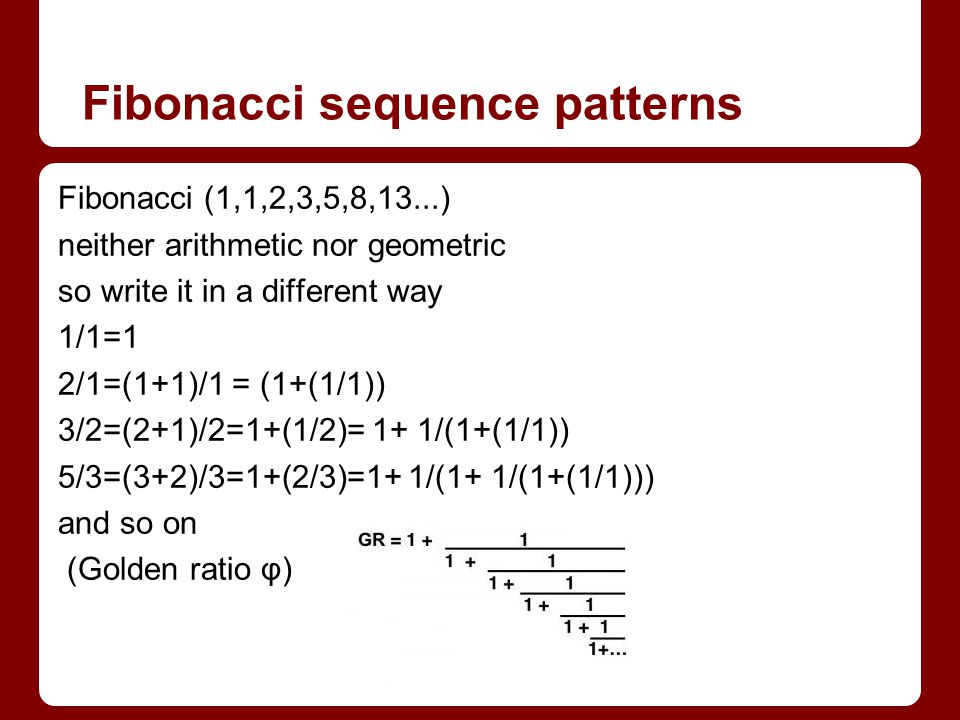


Fibonacci Numbers And Binet Formula An Introduction To Number Theory Ppt Download



Fibonacci Series In Java Vertex Academy
14/03/21 · The Fibonacci series is a very famous series in mathematics Each number in the sequence is the sum of the two previous numbers So, the sequence goes as 0, 1, 1, 2Fibonacci(3) = 1 1 = 2 Fibonacci(4) = 1 2 = 3 Fibonacci(5) = 2 3 = 5 Fibonacci(6) = 3 5 = 8 Fibonacci(7) = 5 8 = 13 Fibonacci(8) = 8 13 = 21 Fibonacci(9) = 13 21 = 34 Fibonacci(10) = 21 34 = 55 Fibonacci(11) = 34 55 = Fibonacci(12) = 55 = 144 Fibonacci(13) = 144 = 233 Fibonacci(14) = 144 233 = 377 The output statements in the flowchart show the3 5 = 8 13 5 8 = 13 21 8 13 = 21 34 13 21 = 34 55 21 34 = 55 Table 1 Fibonacci numbers Fibonacci numbers are a sequence of numbers starting with 0, 1 After the first two numbers, each number in the sequence is calculated by adding the two previous numbers See table 1 Fibonacci numbers were first described in (asiatic) Indian mathematics However, they are
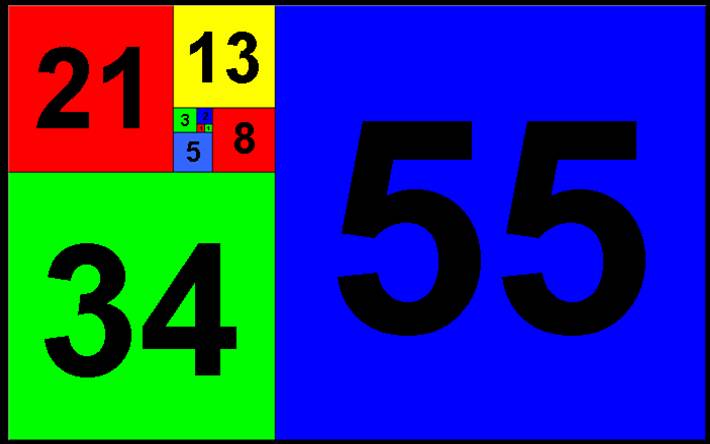


Theorem Of The Day


I Came Up With A Production Challenge Using The Fibonacci Sequence And The Golden Ratio As Graphic Notation Feel Free To Take It On Wearethemusicmakers
Fibonacci sequence is a sequence of numbers, where each number is the sum of the 2 previous numbers, except the first two numbers that are 0 and 1 FibonacciThe resulting sequence is 1, 1, 2, 3, 5, 8, 13, 21, 34, 55, (Fibonacci omitted the first term in Liber abaci Ⓣ) This sequence, in which each number is the sum of the two preceding numbers, has proved extremely fruitful and appears in many different areas of mathematics and science(where Φ = 1618), as 5 divided by 3 is 1666, and 8 divided by 5 is 160 The ratios of the successive numbers in the Fibonacci series quickly converge on Phi, where Phi is called the Golden Ratio After the 40th number in the series, the ratio is accurate to 15 decimal places Φ = ,



A Quasi Fibonacci Series 1 2 3 5 8 13 Of Breaking Download Scientific Diagram



Project Euler 2 Even Fibonacci Numbers Dev Community
11/04/21 · Source code to print fibonacci series in pythonSolve fibonacci sequence using 5 Method 0, 1, 1, 2, 3, 5, 8, 13, 21, 34, 55, ,F 0 0 F 1The Fibonacci Sequence is the series of numbers 0, 1, 1, 2, 3, 5, 8, 13, The next number is found by adding up the two numbers before it The 2 is found by adding the two numbers before it



The Fibonacci Sequence Is The Sequence 0 1 1 2 3 5 8 13 21 Writ



Trading System Fibonacci Retracement Tool Fibonacci Fibonacci Spiral Fibonacci Sequence
The Fibonacci sequence is a series of numbers where a number is the sum of previous two numbers Starting with 0 and 1, the sequence goes 0, 1, 1, 2, 3, 5, 8, 13, 21, and so on Here we will write three programs to print fibonacci series 1) using for loop 2) using while loop 3) based on the number entered by user10/09/19 · The traditional Fibonacci sequence is 1, 2, 3, 5, 8, 13, 21 and so on, with each number the sum of the preceding numbers Years ago I began having teams estimate with a modified Fibonacci sequence of 1, 2, 3, 5, 8, 13, , 40 and 100The problem yields the 'Fibonacci sequence' 1, 1, 2, 3, 5, 8, 13, 21, 34, 55, , 144, 233, 377 Fibonacci omitted the first term (1) in Liber Abaci The recurrence formula for these numbers is F(0) = 0 F(1) = 1 F(n) = F(n − 1) F(n − 2) n > 1 Although Fibonacci only gave the sequence, he obviously knew that the nth number of his sequence was the sum of the two previous



Fibonacci Sequences And Why They Re The Coolest Thing Since Fractions
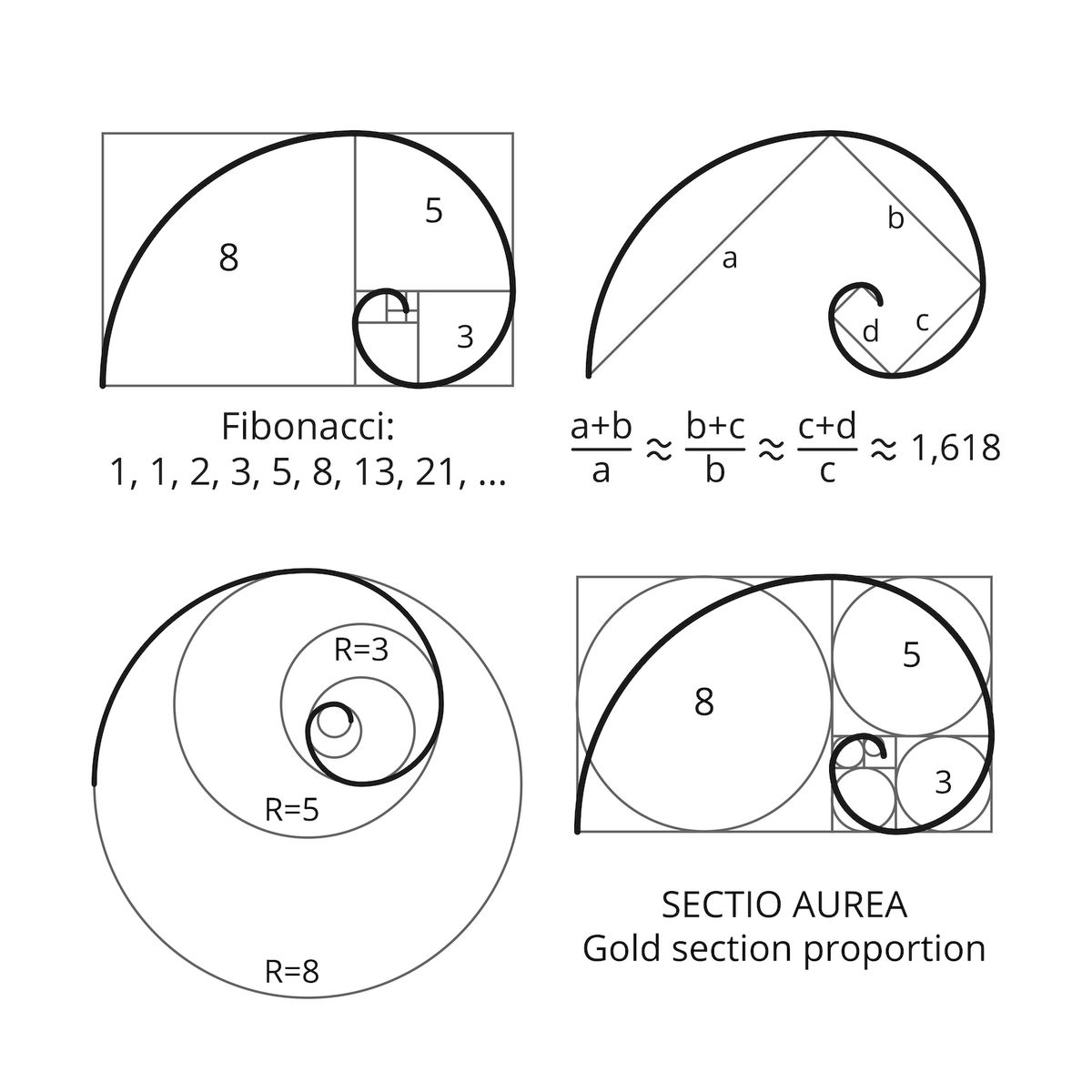


What Is The Fibonacci Sequence Live Science
List of Fibonacci numbers In mathematics, the Fibonacci numbers form a sequence such that each number is the sum of the two preceding numbers, starting from 0 and 1 That is F n = F n1 F n2, where F 0 = 0, F 1 = 1, and n≥2 The sequence formed by Fibonacci numbers is called the Fibonacci sequence The following is a full list of the first 10, 100, and 300 Fibonacci numbersHere are 8 Fibonacci numbers 1, 1, 2, 3, 5, 8, 13, 21 Note that the first Fibonacci number is 1, F(1) = 1 The second Fibonacci number is 1, ie F(2) = 1 Other Fibonacci numbers in the sequence is the sum of two previous Fibonacci numbers For example F(3) = F(2) F(1) In general F(n) = F(n1) F(n2) Write a program to do the following tasks User entries are shown in bold First print21/07/10 · 2 3 = 5 The fifth term is 5 8 Sum the previous two numbers to find any given number in the Fibonacci Sequence When you use this method, you are using the formula = − − Since this is not a closed formula, however, you cannot use it to calculate any given term in the sequence without calculating all the previous numbers Advertisement Method 2 of 2 Using



Based On The Following Power Points Fibonacci Numbers



Solved Fibonacci Numbers Are 0 1 1 2 3 5 8 13 21 34 55 E Chegg Com
JavaScript exercises, practice and solution Write a JavaScript program to get the first n Fibonacci numbersMath problems 2pdf FIBONACCI NUMBERS GET INTO EVERYTHING(0 1 1 2 3 5 8 13 21 34 55 144 233 377 610 987 1597 The Fibonacci sequence may be definedFibonacci Series in C Fibonacci Series in C In case of fibonacci series, next number is the sum of previous two numbers for example 0, 1, 1, 2, 3, 5, 8, 13, 21 etc



1 1 2 3 5 8 13 21 34 Fibonacci Sequence In Nature Patterns In Nature Geometric Pattern



1 1 2 3 5 8 The Golden Ratio Amazing Science Math Art Sacred Geometry Golden Ratio
11/03/21 · The Java Fibonacci recursion function takes an input number Checks for 0, 1, 2 and returns 0, 1, 1 accordingly because Fibonacci sequence in Java starts with 0, 1, 1 When input n is >=3, The function will call itself recursively The call is done two times Let's see the Fibonacci Series in Java using recursion example for input of 4N=1 = (1,1,2,3,5,8,13, ) is the Fibonacci sequence, then Fn = fn f ˆn p 5 = fn (f) n p 5 = 1 p 5" 1 p 5 2!The resulting number sequence, 1, 1, 2, 3, 5, 8, 13, 21, 34, 55 (Fibonacci himself omitted the first term), in which each number is the sum of the two preceding numbers, is the first recursive number sequence (in which the relation between two or more successive terms can be expressed by a formula) known in Europe Terms in the sequence were stated in a formula by the Frenchborn



Fibonacci Series Program In C



Based On The Following Power Points Fibonacci Numbers
List of Fibonacci Numbers Fibonacci Sequence List Access Premium Version × Home Health and Fitness Math Randomness Sports Text Tools Time and Date Webmaster Tools Miscellaneous Hash and Checksum ☰ ADVERTISEMENT Online Tools and Calculators > Math > List of Fibonacci Numbers List of Fibonacci Numbers First Fibonacci Numbers List of First 15 Fibonacci Numbers F n Number;Conferenza del ciclo Young Doctors for Science 2 tenuta il 27 febbraio 13 presso il Civico Planetario "FMartino" di ModenaRelatori Dottssa Elena Magnan26/02/16 · From the above, Our final output of Next values are 0 1 1 2 Fibonacci Series program Using For Loop This Python Fibonacci Series using for loop example allows the user to enter any positive integer Next, this program displays the Fibonacci series of numbers from 0 to userspecified numbers using Python For Loop # Python Fibonacci series Program using For Loop # Fibonacci



Fibonacci The Golden Mean And Nature The Fibonacci Sequence 1 1 2 3 5 8 13 21 34 55 Is An In Fractals In Nature Geometry In Nature Spirals In Nature


The Numbers Of Nature The Fibonacci Sequence Eniscuola
Ans = 1 1 2 3 5 8 13 21 34 55 Fibonacci Sequence Approximates Golden Ratio The ratio of successive Fibonacci numbers converges to the golden ratio 1 6 1 8 0 325/10/ · 1 Fibonacci numbers are a sequence of numbers ie 1,1,2,3,5,8,13,21,34 2 Write the next terms of the sequence generated by it?13/12/19 · The Fibonacci sequence is a series of numbers in which each number is the sum of the two preceding ones, which is 0, 1, 1, 2, 3, 5, 8, 13, 21, 34, 55, Therefore, 0 1 = 1, 1 1 = 2, 1 2 = 3 and so on Go ahead, try it yourself!



1 1 2 3 5 8 The Golden Ratio Golden Ratio Golden Ratio Spiral Patterns In Nature



Slides Show
A Fibonacci sequence is the integer sequence of 0, 1, 1, 2, 3, 5, 8 The first two terms are 0 and 1 All other terms are obtained by adding the preceding two terms This means to say the nth term is the sum of (n1)th and (n2)th termN 1 p 5 2!



Fibonacci I Learn Forex I Signal Skyline



Fibonacci Numbers Fibonacci Numbers Fibonacci Numbers 0 1 1 2 3 5 8 13 21 34 Where Each Number Is The Sum Of The Preceding Two Recursive Ppt Download



0 1 1 2 3 5 8 13 21 34 55 Scientific Scribbles



The Life And Numbers Of Fibonacci Plus Maths Org
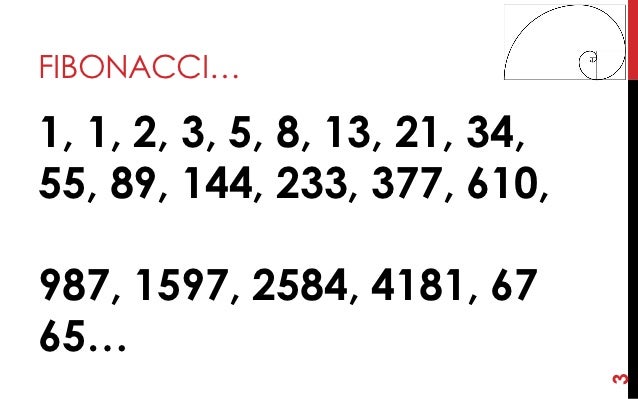


Golden Ratio



Fibonacci Numbers Consequences Of Fibonacci Numbers How Many



Program To Display Fibonacci Series 0 1 1 2 3 5 8 13 21 34 55 Fibonacciseries Crpogramming Youtube



The Fibonacci Sequence Spirals And The Golden Mean



The Fibonacci Sequence 1 1 2 3 5 8 13 Chegg Com


What Is The Pattern Of Sequence 1 1 2 3 5 8 13 Quora
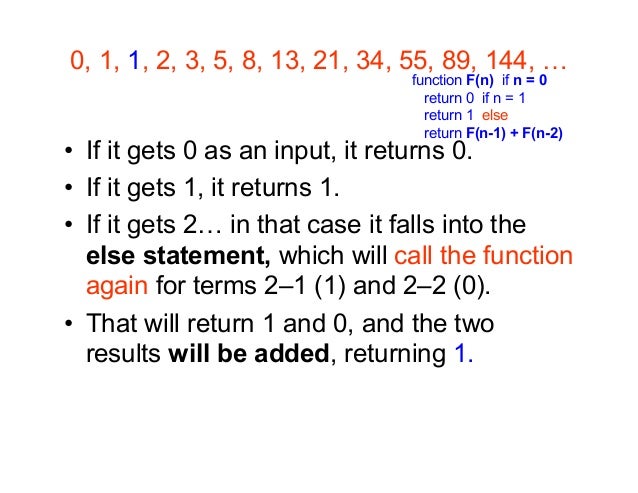


Effective Algorithm For N Fibonacci Number By Professor Lili Saghafi
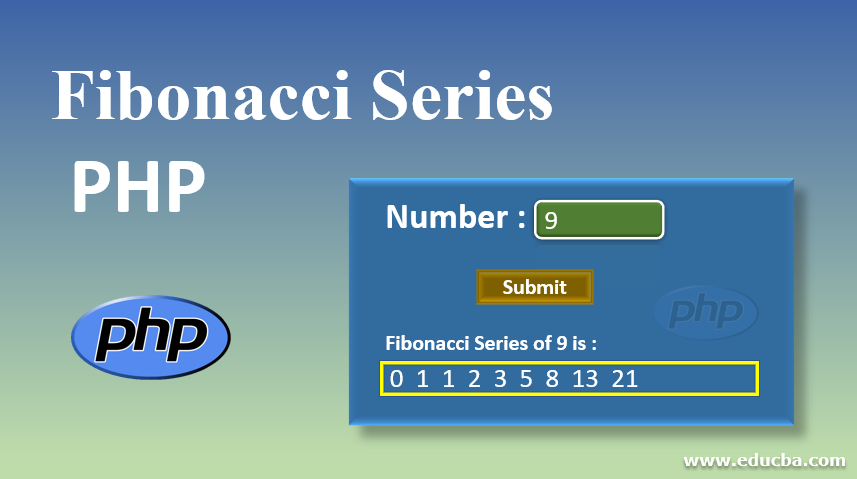


Fibonacci Series Php Php Lines For Fibonacci Series With 2 Approaches



7 The Fibonacci Sequence



Things You Didn T Know About The Fibonacci Sequence Vincit
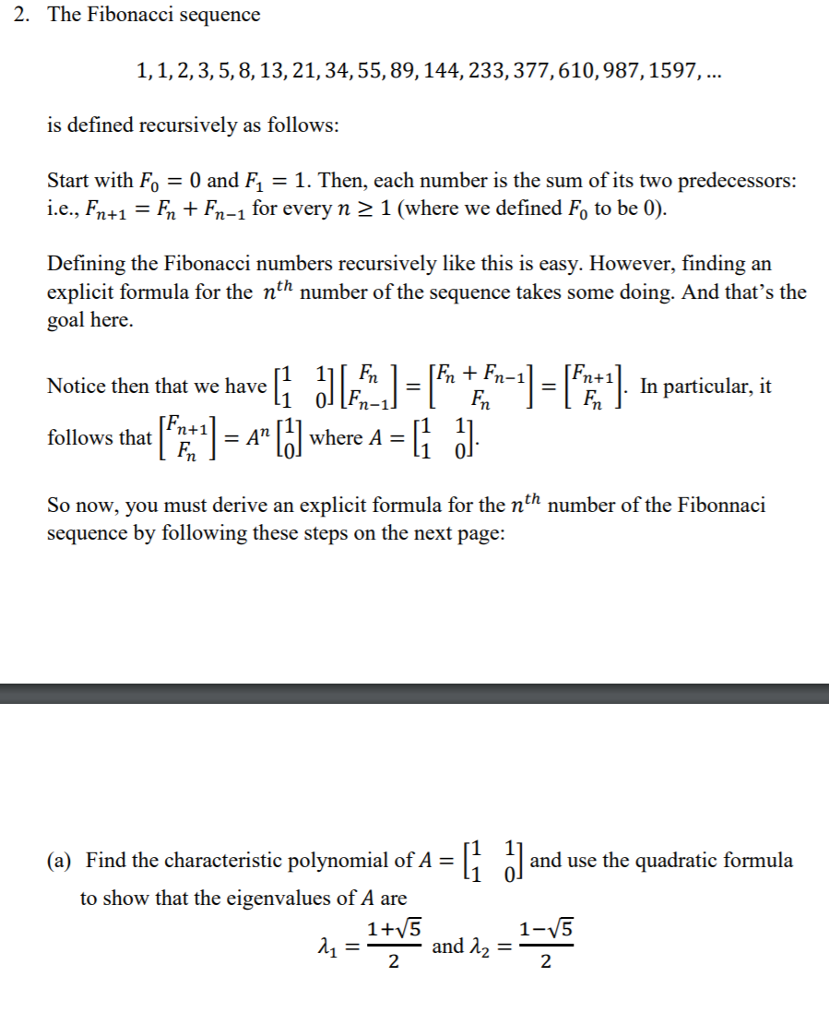


Solved 2 The Fibonacci Sequence 1 1 2 3 5 8 13 21 34 55 Chegg Com
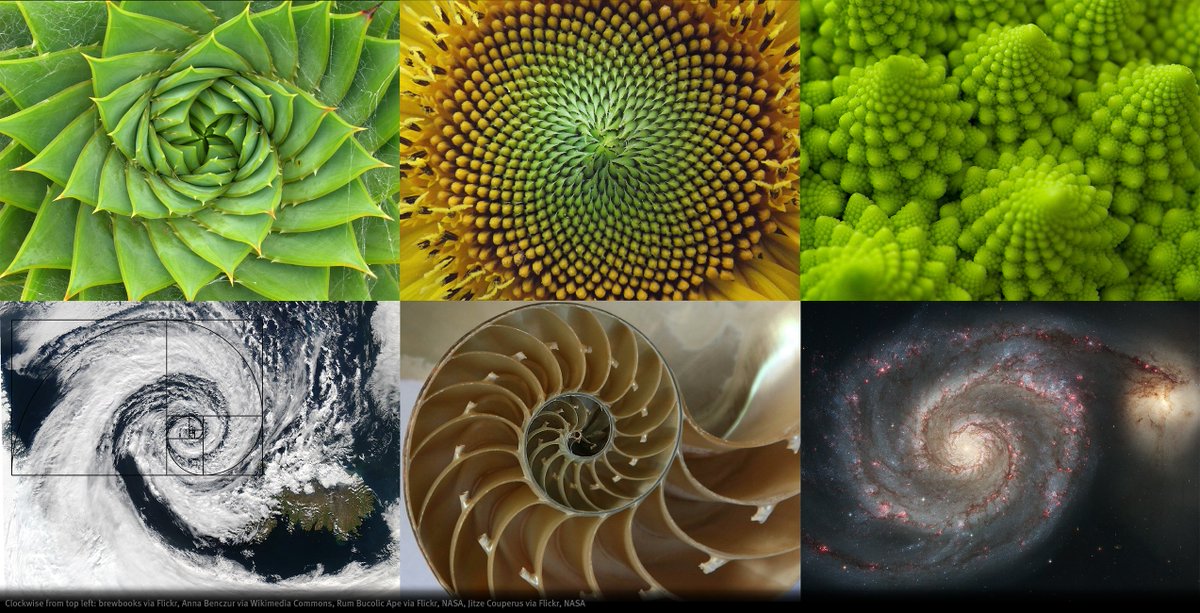


Royal Institution 1 1 2 3 5 8 Who Do We Appreciate Fibonacci Because It S Fibonacciday 11 23 0 1 1 2 3 5 8 13 21 34 55 144 233 377 610 987 1597 2584 4181 6765 T



Fibonacci Numbers Sequence Book Schoolworkhelper



It S The 1 1 2 3 5 8 13 Day Thread The Avocado



Fibonacci Numbers Consequences Of Fibonacci Numbers How Many



Fibonacci Functional Programming A Walkthrough By William Elliott Medium



Q10 Write A Recursive Function To Obtain The First 25 Numbers Of A Fibonacci Sequence In A Fibonacci Sequence The Sum Of Two Successive Terms Gives The Third Term Following Are The
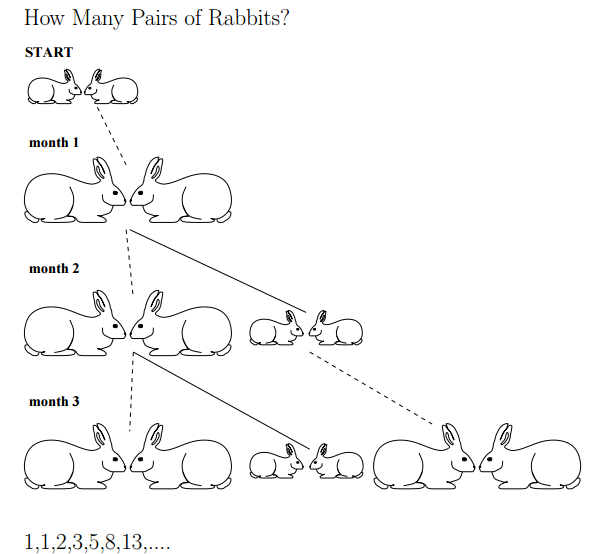


Define Fibonacci Numbers
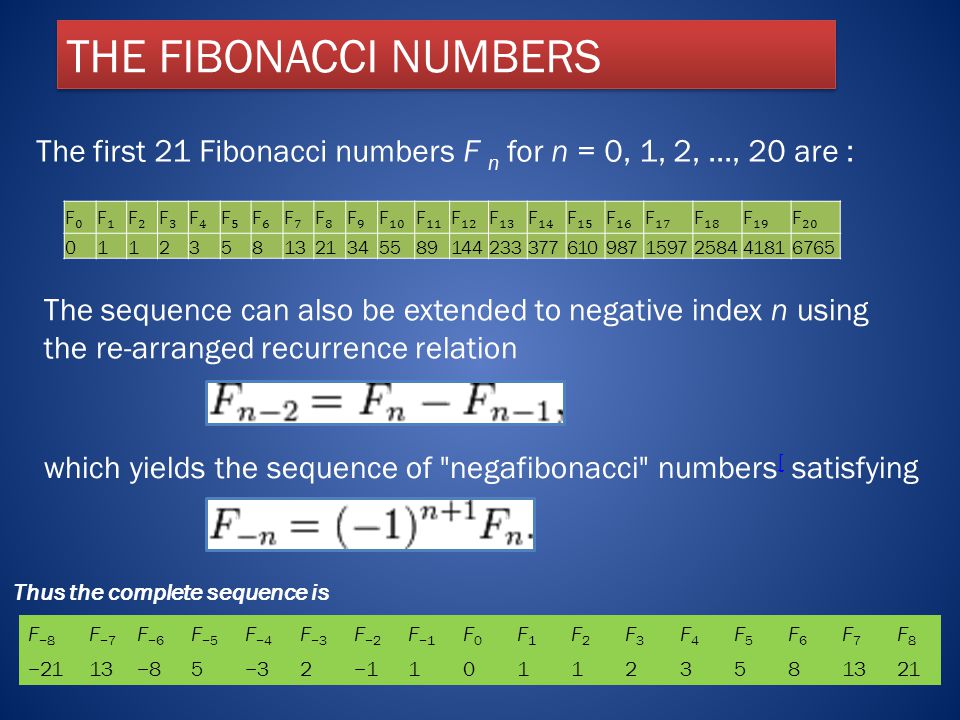


Fibonacci Numbers 0 1 1 2 3 5 8 13 21 34 55 144 233 377 610 987 1597 2584 4181 6765 Ppt Video Online Download



Fibonacci Numbers 0 1 1 2 3 5 8 13 21 34 55 144 233 377 610 987 1597 2584 4181 6765 Ppt Video Online Download



Fibonacci Sequence Equation Page 1 Line 17qq Com



2 Some Facts About Fibonacci Sequence 0 1 1 2 3 5 8 13 21 34 55 For N 0 For N 1 F 1 Ffor Homeworklib



The Fibonacci Sequence Nanotedsla



Fibonacci Number Wikipedia



10 Facts On Leonardo Fibonacci And The Fibonacci Sequence Learnodo Newtonic



F Fibonacci Sequence Fibonacci
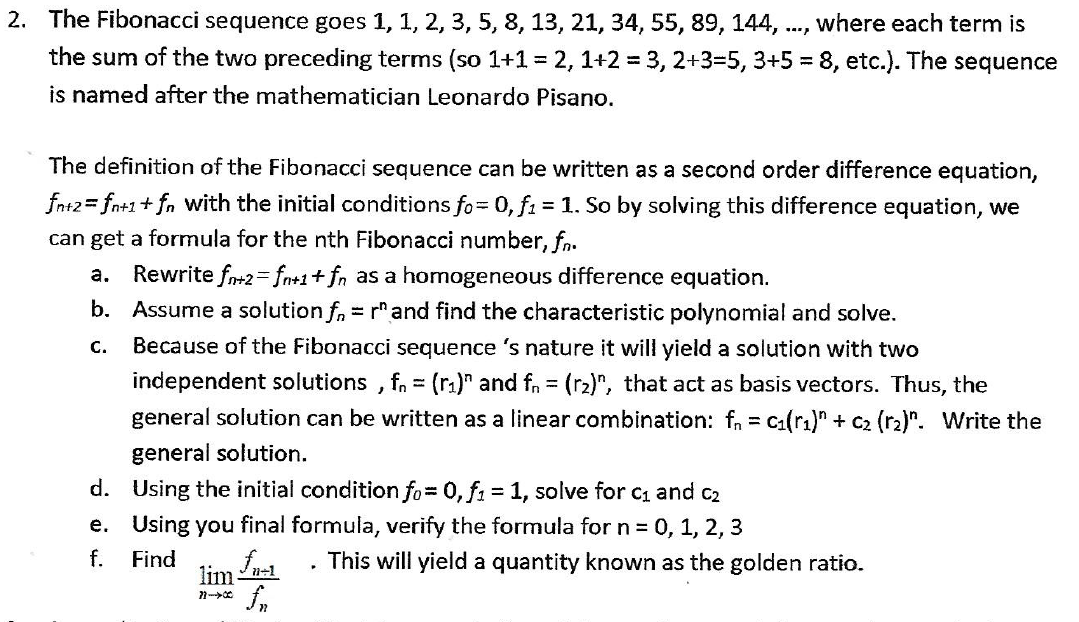


Solved The Fibonacci Sequence Goes 1 1 2 3 5 8 13 21 Chegg Com
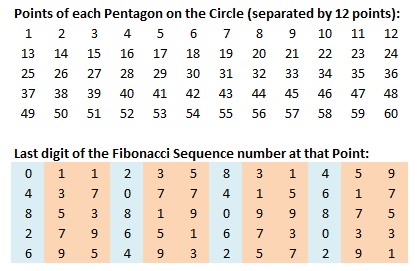


Fibonacci 60 Repeating Pattern The Golden Ratio Phi 1 618



Fibonacci Numbers 1 1 2 3 5 8 13 The Smart Kids Club
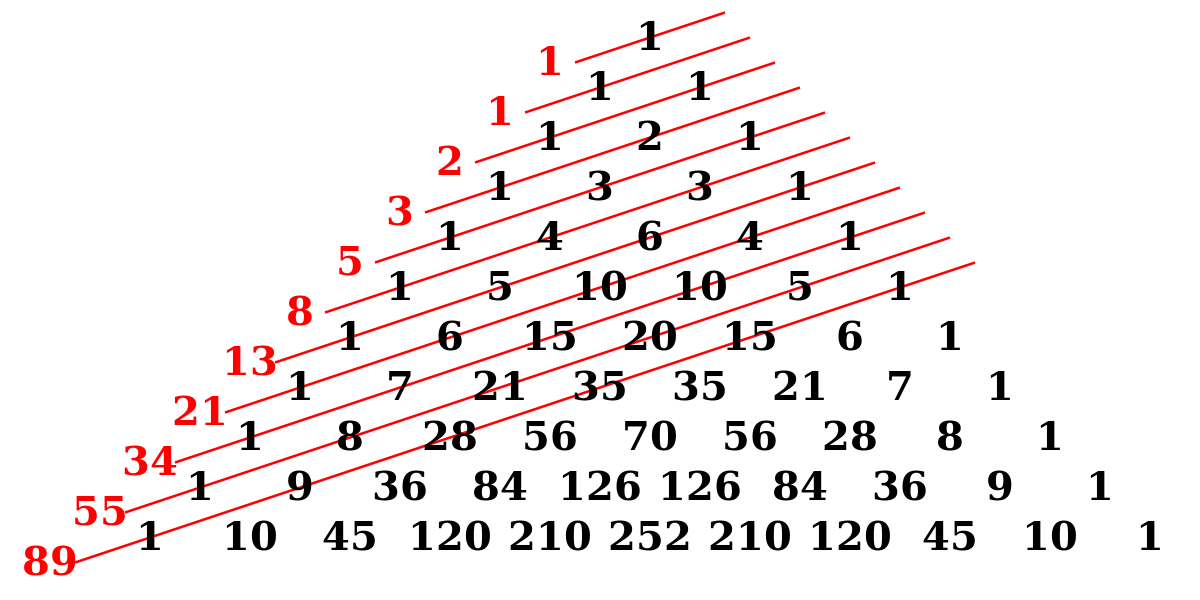


Fibonacci Sequence Wikidata



Technology Analysis Of Python Classic Interview Questions Implementing The Fibonacci Sequence Programmer Sought



Fibonacci Series Debunked Oli Freke
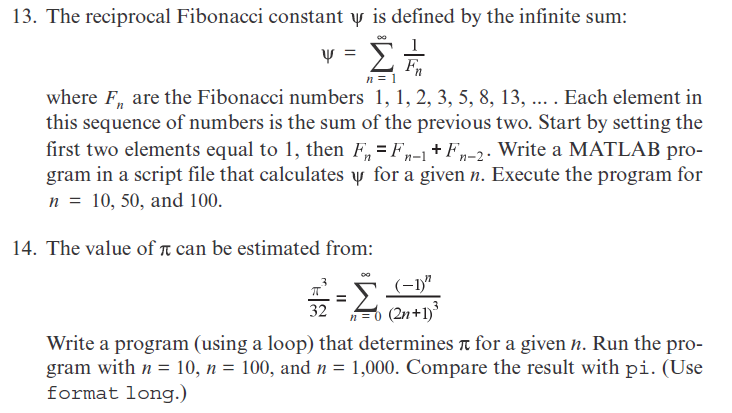


Answered 13 The Reciprocal Fibonacci Constant Y Bartleby


Github Wdi Sg Fibonacci Numbers Javascript Morning Exericse Generate First N Fibonacci Numbers



In Mathematics The Fibonacci Sequence Is 0 1 1 2 3 5 8 13 Each Number The Sum Of The Previous Two Fibonacci Fibonacci Sequence Fibonacci In Nature
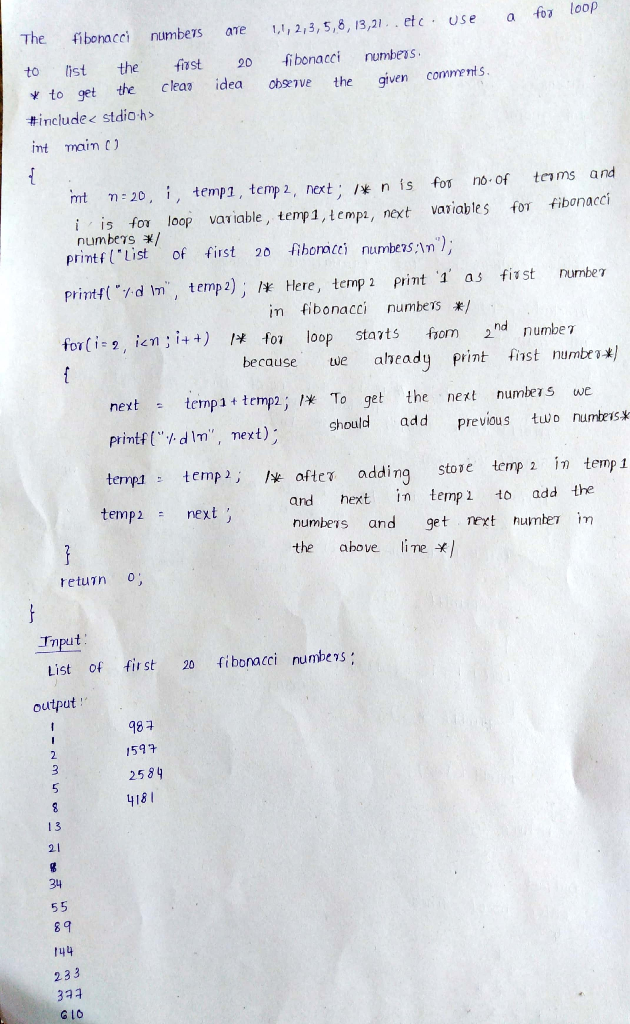


Solved Fibonacci Numbers 1 1 2 3 5 8 13 21 Etc Use Loop List First Fibonacci Numberscreate Tri Q



The Fibonacci Sequence Youtube



Fibonacci Sequence Number Patterns Youtube


1 1 2 3 5 8 13 21 34


The Golden Ratio Multiplier Unlocking The Mathematically Organic By Philip Swift Positivecrypto Medium



The Fibonacci Sequence 0 1 1 2 3 5 8 13 21 34 Helps Breaktrhough Several Global Challenes Youtube


Fibonacci 60 Code Jain 108



Wk7 51 Algorithm Fibonacci Sequence 0 1 1 2 3 5 8 13 31 35 N Youtube



Where Were Fibonacci Series Used Quora
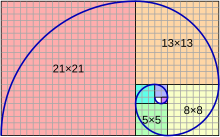


Gc8bxqt Fibonacci Sequence 3 5 8 Traditional Cache In Washington United States Created By Leon0112



Dataweave 2 Generate Fibonacci Sequence Java Streets



Fibonacci Sequence



Pin By Coach Tammy On Fibonacci Fractals Mandalas Sacred Geometry And God S Designs Fibonacci Sacred Geometry Golden Ratio



Fibonacci 60 Code Jain 108
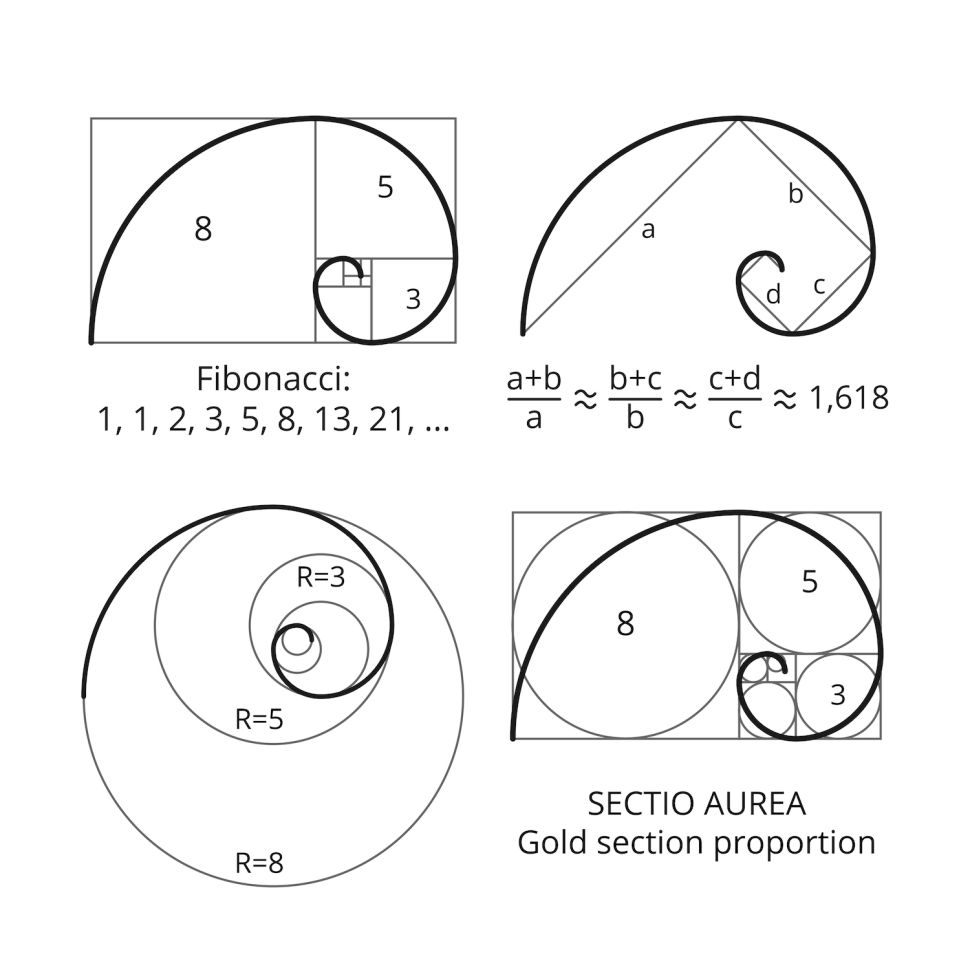


The Fibonacci Series Star Magic


What Is The Next Number In The Sequence 0 1 1 2 3 5 Quora



Tcs Coding Practice Question Fibonacci Series Geeksforgeeks



Fibonacci Series In Python Python Program To Print The Fibonacci Sequence



Trading With Fibonacci Retracements And Expansions Fxtrading Com International
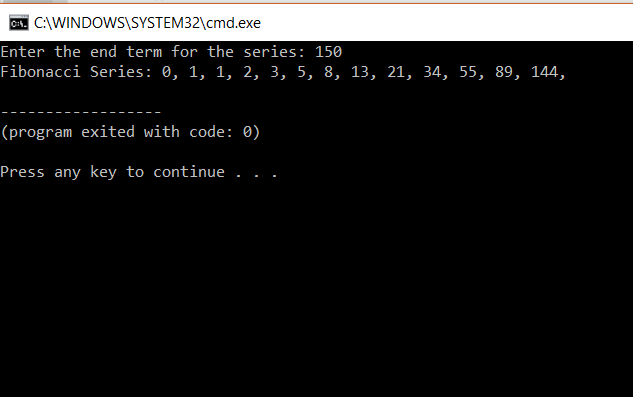


Fibonacci Series In C Edureka


What Is The Pattern Of Sequence 1 1 2 3 5 8 13 Quora
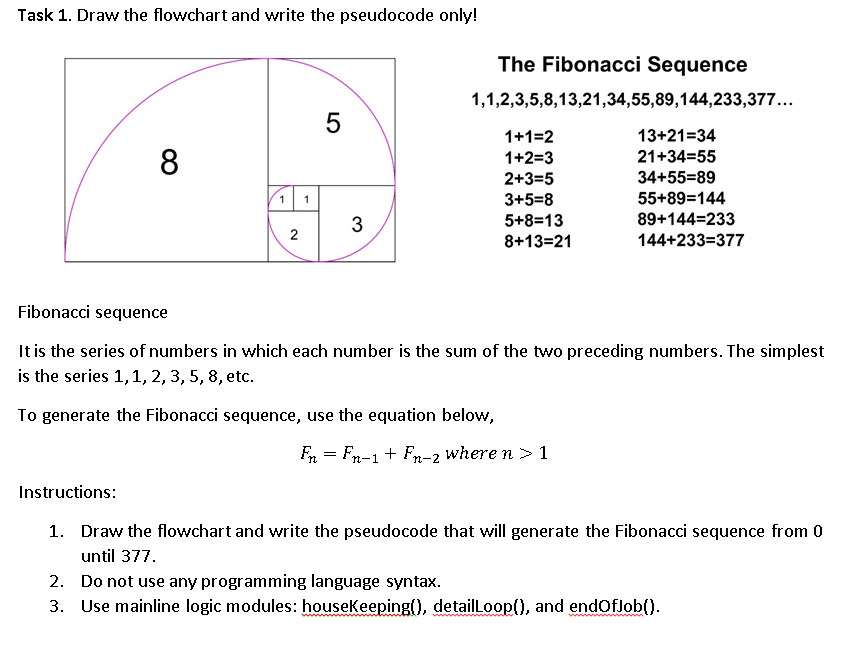


Solved Task 1 Draw The Flowchart And Write The Pseudocod Chegg Com



Math In Nature Fibonacci Sequence In Nature The Sequence Begins With Numbers 0 1 1 2 3 5 8 13 21 34 55 144 And Continues Ppt Download



Stock Market Scientist בטוויטר Fibonacci Simplified Its A Concept Developed By Mathematician Leonardo Fibonacci In 13th Century Fibonacci Sequence Is A Series Of Numbers From 1 To Infinity As Each Number Is
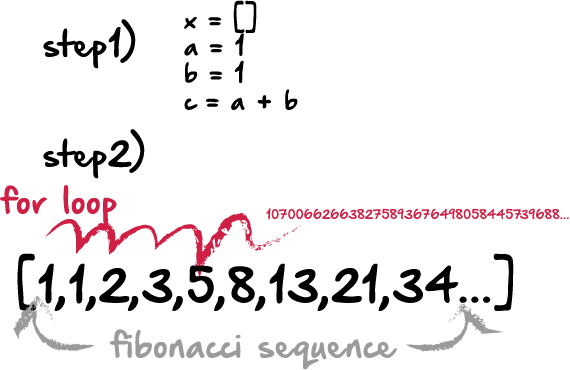


The Fibonacci Sequence To The Nᵗʰ Number Python Javascript Hacker Noon
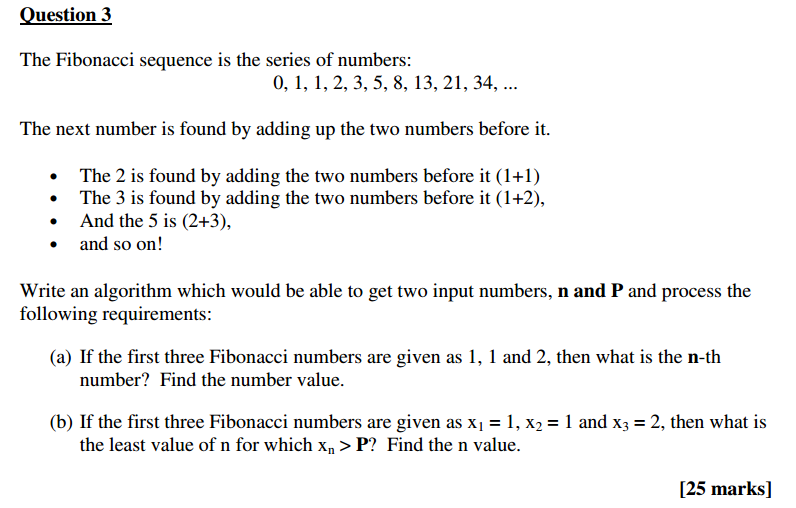


Solved The Fibonacci Sequence Is The Series Of Numbers 0 Chegg Com
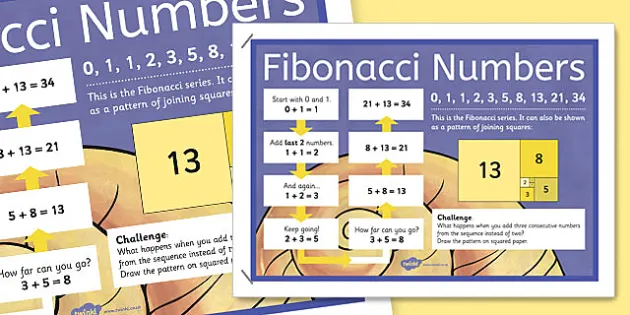


Fibonacci Numbers Display Poster Teacher Made



Number Series And Puzzles Tricks And Solutions 1 1 2 3 5 8 13 Youtube
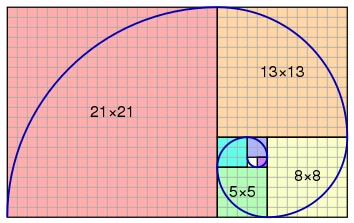


Fibonacci Numbers Logarithmic Spiral Crystalinks
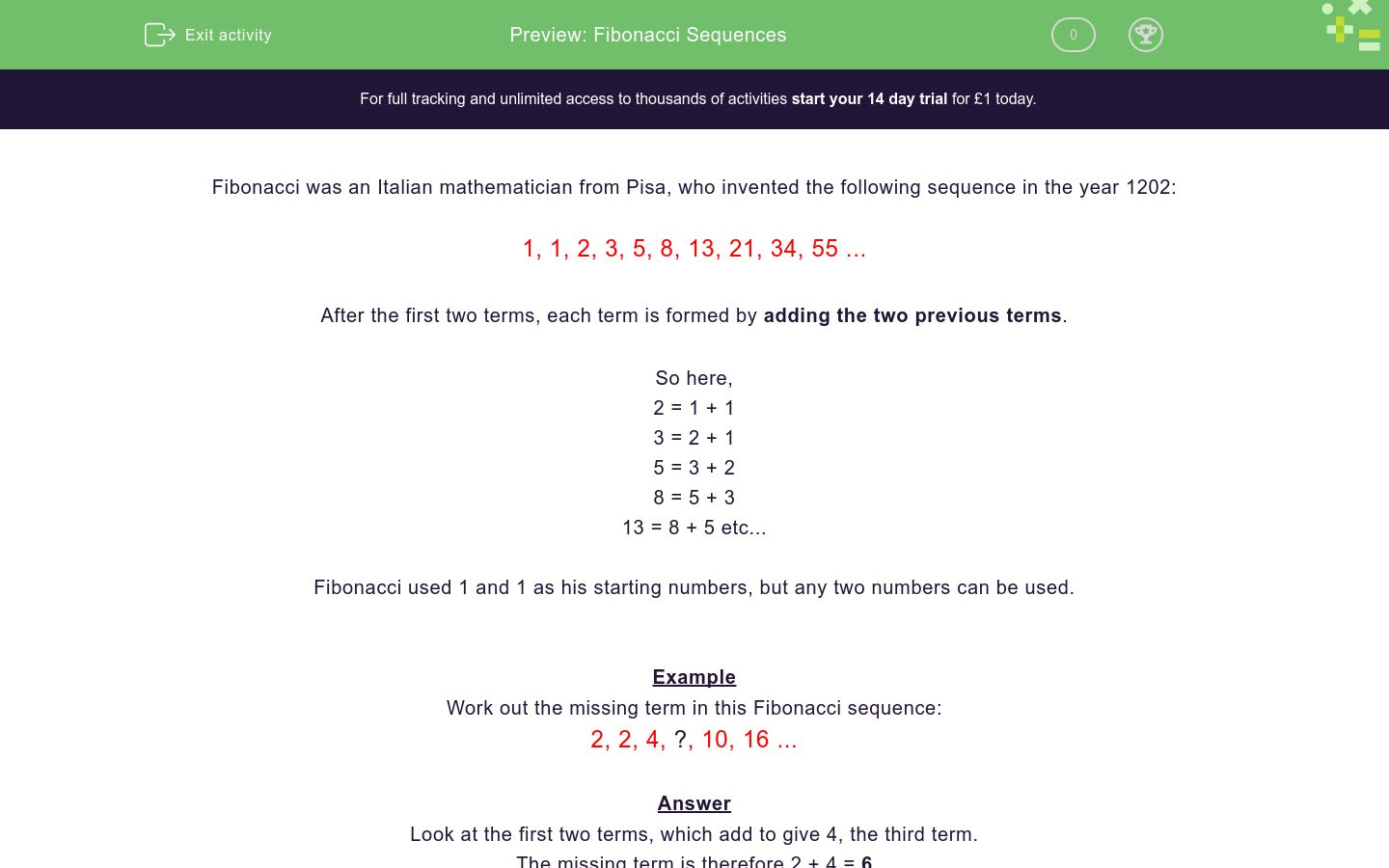


Fibonacci Sequences Worksheet Edplace



Generalized Fibonacci Sequence And The Golden Ratio Wolfram Demonstrations Project



Fibonacci Number Nbsp Fibonacci Number 1 Fibonacci Number A Tiling With Squares Whose Sides Are Successive Fibonacci Numbers In Length A Fibonacci Spiral Created By Drawing Circular Pdf Document



Growing Patterns Fibonacci Numbers In Nature Amazon Co Uk Sarah C Campbell Books
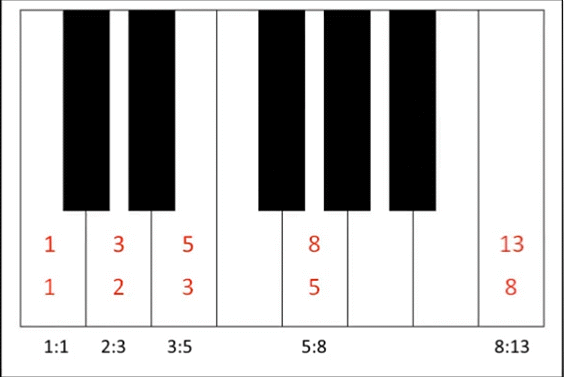


Music And The Fibonacci Sequence And Phi The Golden Ratio Phi 1 618



Pin On Something Naturally Curious



Fibonacci Sequence Significant Coincidence Jay Petrie S Uod Eportfolio



Maths Tricks And Tips Fibonacci Sequence



Math In Flowers Symmetry Fibonacci And A Fun Video Shade Metals



Calameo Fibonacci Numbers And The Golden Section Pdf


コメント
コメントを投稿